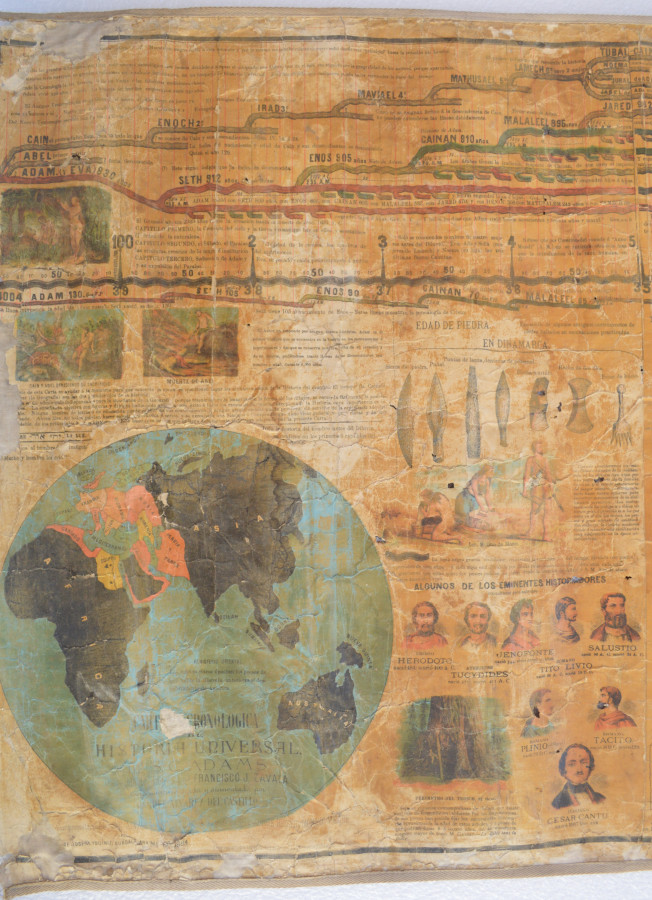The
Carta Sincronológica de la Historia Universal is a horizontal encyclopedia divided into fourteen fragments or panels, which joined together link up and visually narrate the history of humanity from the creation of Adam and Eve to the “current” governors of the world, that is, those in power in 1884 when it was created. The chart is designed to be stored rolled up, and when fully unrolled it measures 70 cm in height by 6.78 m in length.
In Mexican history, the period known as the
Porfiriato (1875-1911) refers to the time in which Porfirio Díaz was in power. This epoch was characterized by development in: industry and mining; means of communication such as railroads and telegraph; science and architecture; arts and foreign investment. This led to the transformation of many cities and various sectors of society, the economy and indeed education.
Over these decades, Aguascalientes in common with other Mexican cities experienced an economic boom as it developed industries such as mining. People also arrived from abroad who had an impact on different aspects of daily life in Aguascalientes. This led to the modernization of the city and construction of spaces for recreation such as the Plaza Principal and the Morelos Theater; educational institutions such as the Institute of Sciences and the Girls’ School; and even the construction of new cemeteries including Los Ángeles and La Cruz. The period also saw the erection of markets and the embellishment of public gardens and thoroughfares.
During the
Porfiriato, one of the philosophical reference points for the actions taken by the government was Positivism, a strand of thought developed by French scholar Auguste Comte that proclaimed the sole source of true and authentic knowledge to be the concrete or empirical sciences (biology, astronomy, botany, geography, physics and sociology).
The spread of Positivism in Mexico is attributed to Gabino Barreda. This trend in thought had the objective of establishing the “Order” that the country was thirsty for after decades of political, economic and social instability; subsequently to arrive at the heralded “Progress” in line with the policy of the regime.
With regard to the study of history, the emphasis was on great events and Mexican and global figures as undeniable evidence for the present day. Auguste Comte didn’t consider history to be a science, but proposed that the study of historical events should be part of general education. Within his theory, Comte divided the study of history into three great phases: theological-military, metaphysical-judicial, and scientific-industrial.
Characteristics of the document:
- The Carta Sincronológica de la Historia del Mundo is a large-format print (70 cm x 6.78 m)
- In this chart, the students learned about events and figures from world history through illustrations and texts.
- In Mexico, the Carta Sincronológica de la Historia del Mundo was translated in 1884 by Francisco J. Zavala, taking as a model the Chronological Chart of Ancient, Modern and Biblical History published by Sebastian C. Adams in 1870.
- The system used by the Carta Sincronológica de la Historia del Mundo attempts to synchronize biblical history with elements of the political, cultural, social and economic history of the world.
- The Carta Sincronológica de la Historia del Mundo comprises 13 joined sheets that were originally folded like a screen, allowing it to be consulted page by page like a book, or alternatively unfolded to view the full extension of history.
- The Carta was produced using a four-color chromolithography technique on industrial chemical-pulp paper.
About the author and the Mexican editionThe American Sebastián C. Adams served as County Clerk and as State Senator while living in Yamhill County, but by 1869 had settled in Salem with his family. While serving as a local preacher at First Christian Church Adams continued as an educator, particularly exploring new methods to improve the teaching of history. He also published many articles dealing with the origins of religion.
In 1871, his
Chronological Chart of Ancient, Modern and Biblical History was published by Strobridge & Company of Cincinnati, Ohio, the premier publisher of American commercial art. The technique of chromolithography offered the emerging middle class affordable color reproductions and, in this case, made lessons of history colorful and dramatic. Adams spent the next six years traveling, successfully selling the publication at a low cost.
In the 1880s, Francisco J. Zavala carried out the Spanish translation and reprinting of this document in the city of Guadalajara, Mexico. The practice of lithography in Jalisco involved numerous artists in the 1800s, among the most notable being Gonzalo Ancira, a native of Coahuila who came to live in Guadalajara with his family in 1865, under the aegis of Dionisio Rodríguez.
During a trip he made to the United States he acquired new techniques enabling his lithography workshop to become one of the best in the country. Over his professional career he won several prizes at different exhibitions. His principal works include the full-size portrait of Sebastián Lerdo de Tejada; the Funeral Wreath of his friend Dionisio Rodríguez; and the drawings for the
Carta Sincronológica de la Historia Universal, produced in 1882.
What does the Carta Sincronológica de la Historia del Mundo contain?In the upper third and throughout the work, Biblical history is recounted from Adam and Eve to the death of Christ, followed by a chronology of saints and events in the Catholic Church and in Europe. Beginning in the 11
th century the history of America appears, interwoven with events in Europe, while from the 16
th century up to 1885 it shows the history of Mexico and the United States.
The two lower thirds cover ancient cultures, initially, before an image of the Tower of Babel gives way to an explanation of the populating of Phoenicia, Egypt, Babylon and Greece. Oriental cultures such as India and China also appear, revealing a chronological parallel that leads up to the 19
th century.
In the final part of the chart, there appear portraits of the governors of Mexico, from the last Aztec emperor to Porfirio Díaz, as well as from the rest of the world. In addition, events in the Americas and Mexico are depicted, mainly involving figures of global fame.
The Mexican edition of the
Carta Sincronológica depicts a tree of illustrations that document the development of peoples and knowledge that, from the perspective of positivism and the Judeo-Christian tradition that prevailed in certain intellectual sectors of the 19th century, formed the benchmarks of human history.







